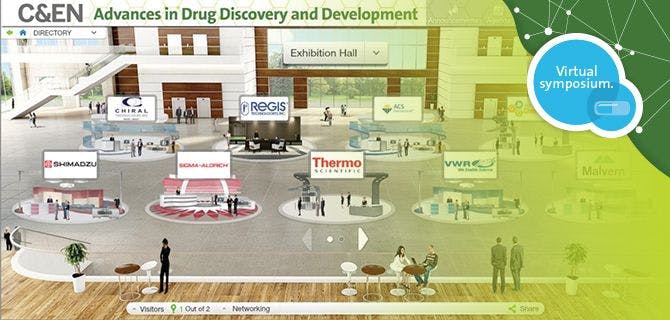On September 16, 2015, scientists from biotech, pharma and academia will present the latest research findings and new technologies that are driving the design, discovery and development of new drugs – from traditional small molecules and biologics to cutting-edge gene-editing and immunological technologies. Speakers will present the latest advances in identifying promising drug targets, verifying […]

On September 16, 2015, scientists from biotech, pharma and academia will present the latest research findings and new technologies that are driving the design, discovery and development of new drugs – from traditional small molecules and biologics to cutting-edge gene-editing and immunological technologies. Speakers will present the latest advances in identifying promising drug targets, verifying lead compounds, and new strategies that are delivering more powerful, personalized drugs to the marketplace. Register for free today.
Last year, more than 7,500 scientists signed up to attend C&EN’s inaugural virtual symposium. A free event, attendees can listen to presentations, “walk the floor” in a virtual exhibition hall and career fair, and network with their peers in an easy, convenient environment – straight from your device of choice.
C&EN Virtual Symposium Speaker Snapshot: Christopher P. Austin, M.D., was trained as both a researcher and clinician. Now he directs the National Center for Advancing Translational Sciences (NCATS) at the National Institutes of Health. Dr. Austin will be speaking during C&EN’s Virtual Symposium on Advances in Drug Discovery and Development next month. Click to read his pre-event Q&A and get his take on the world of translational medicine.
C&EN Virtual Symposium Keynote Q&A
Christopher P. Austin, M.D., was trained as both a researcher (developmental neurogenetics) and clinician (internal medicine and neurology). Now he directs the National Center for Advancing Translational Sciences (NCATS) at the National Institutes of Health (NIH). Dr. Austin will be speaking during C&EN’s Virtual Symposium on Advances in Drug Discovery and Development, September 16, 2015 at 1:00pm ET.
Read on to learn how NCATS works to improve the translation of observations in the laboratory, clinic and community into interventions that improve the health of individuals and the public.
C&EN: Thanks for speaking with us. Can you tell us how your background as a neurologist has shaped your efforts to improve translational medicine?
Austin: It was my experience as a neurologist seeing patients with devastating diseases for which there are no treatments that drove me to translation — the field that creates new interventions that will provide those desperately needed treatments. What I had discovered was that the current process for creating new drugs and other interventions is poorly understood, failure-prone, time-consuming and expensive. This is why I decided to focus on improving the process of translation through the study of translational science — to create the understanding that will enable new treatments to be developed faster.
C&EN: You’ve described translation as a team sport. What do you mean by that?
Austin: The process of creating, testing and deploying a novel intervention and demonstrating that it improves human health — that is, “translation” — requires upwards of a dozen scientific and medical disciplines, as well as tech transfer, legal, ethical and often business expertise, over the course of a decade or more. This process is so complex and multifaceted that there is simply no way any one individual can accomplish translation alone. Rather, it requires a team, defined as top performers with a wide variety of different expertise to work together toward a common goal.
C&EN: What do you see as the most significant hindrance to translational success?
Austin: Most scientists, clinicians, policymakers and members of the public do not realize that the translation process exists, or greatly underestimate its scientific and operational complexity. One cannot successfully solve a problem without knowing that it exists, so I spend a great deal of time explaining and educating, and getting people excited about the opportunities and potential in translation.
C&EN: NCATS has only existed since 2011. What have been its successes so far, and what are you excited for in its near future?
Austin: The Toxicology in the 21st Century (Tox21) program has generated millions of data points relating chemicals to specific biological effects and made those data public, leading to remarkable new predictive algorithms. The Tissue Chip for Drug Screening program has created multicellular organoids that recapitulate structural and functional features of many human organs on microfluidic platforms known as “tissue chips”; these are used to mimic living organs and their responses to drugs and environmental chemicals.
Our Discovering New Therapeutic Uses for Existing Molecules program has improved the process for finding new therapeutic indications for investigational drugs; we recently announced a compound originally developed to treat cancer may be effective in treating Alzheimer’s disease. And, through our Clinical and Translational Science Awards program and Rare Diseases Clinical Research Network, NCATS is tackling the systematic issues that hinder translational progress.
Going forward, I could not be more excited about new developments that will be announced shortly in all these areas, as well as from our efforts in chemical genomics and rare diseases therapeutic development. I hope readers will keep up with us at ncats.nih.gov.
Thanks once again to Dr. Austin for sharing his insights with C&EN and the Virtual Symposium attendees. To hear more about this important work, watch Dr. Austin’s live presentation on September 16th by registering for free today. Be sure to add his presentation to your agenda! We look forward to seeing you there.